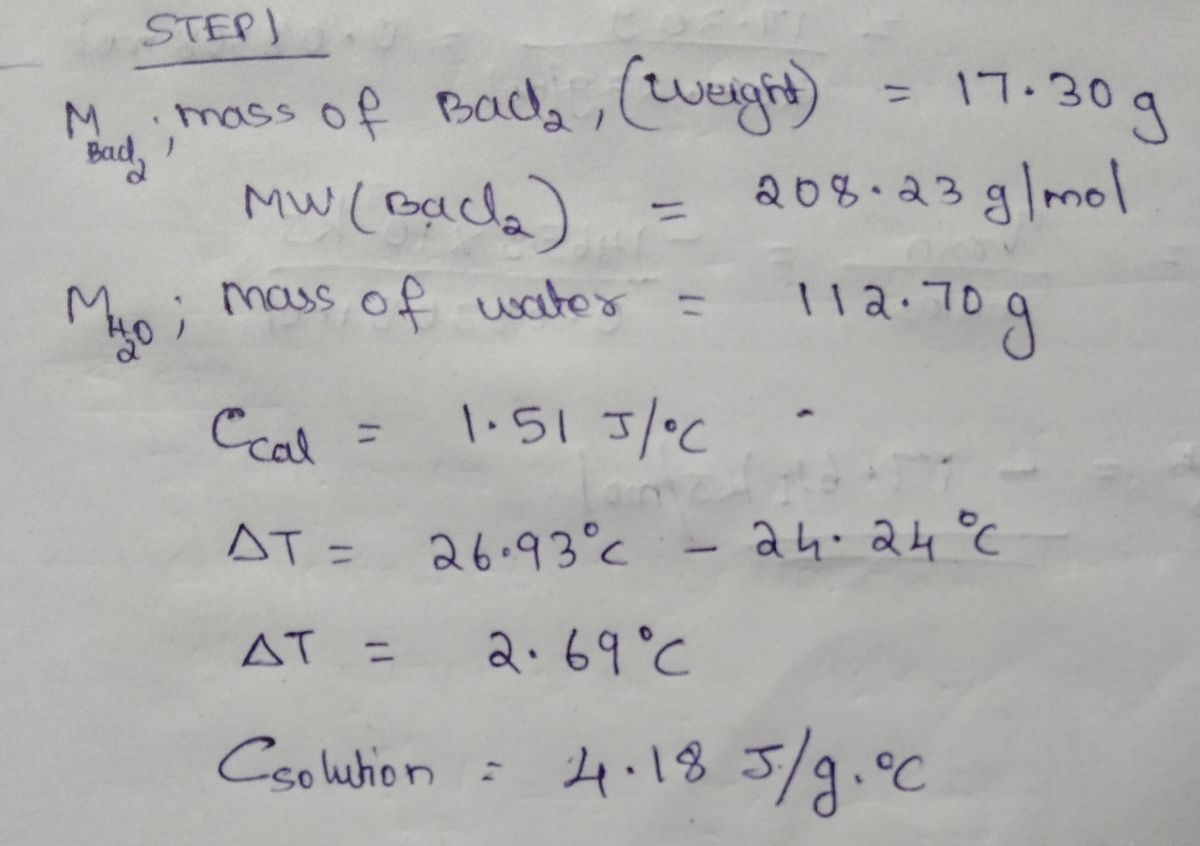Chemistry
10th Edition
ISBN:9781305957404
Author:Steven S. Zumdahl, Susan A. Zumdahl, Donald J. DeCoste
Publisher:Steven S. Zumdahl, Susan A. Zumdahl, Donald J. DeCoste
Chapter1: Chemical Foundations
Section: Chapter Questions
Problem 1RQ: Define and explain the differences between the following terms. a. law and theory b. theory and...
Related questions
Question

Transcribed Image Text:**Understanding Dissolution Enthalpy in Chemistry**
When a solid dissolves in water, the resulting solution may experience a temperature change, becoming either hotter or colder. This temperature change is related to the concept of dissolution enthalpy, which can be accurately measured using a coffee cup calorimeter.
**Laboratory Experiment: Dissolution of BaCl₂**
In a laboratory setting, a general chemistry student observed the following during an experiment involving the dissolution of BaCl₂:
- **Mass of BaCl₂**: 17.30 g
- **Mass of water**: 112.70 g
- **Initial temperature of solution**: 24.24 °C
- **Final temperature of solution**: 26.93 °C
This indicates a temperature increase of the solution from 24.24 °C to 26.93 °C.
**Calorimeter Heat Capacity**
The heat capacity of the calorimeter used in this experiment (also referred to as the calorimeter constant) was previously determined to be 1.51 J/°C.
**Calculating Dissolution Enthalpy**
To find the dissolution enthalpy of BaCl₂ in kilojoules per mole (kJ/mol), use the temperature change data along with the heat capacity of the calorimeter. Assume that the specific heat capacity of the solution is equivalent to that of pure water.
**Expression for Dissolution Enthalpy**
Δ_disH = ____ kJ/mol
This field remains to be completed with the calculated value based on the student’s observations and the calorimeter data.
Expert Solution
Step 1

Step by step
Solved in 2 steps with 2 images

Knowledge Booster
Learn more about
Need a deep-dive on the concept behind this application? Look no further. Learn more about this topic, chemistry and related others by exploring similar questions and additional content below.Recommended textbooks for you

Chemistry
Chemistry
ISBN:
9781305957404
Author:
Steven S. Zumdahl, Susan A. Zumdahl, Donald J. DeCoste
Publisher:
Cengage Learning

Chemistry
Chemistry
ISBN:
9781259911156
Author:
Raymond Chang Dr., Jason Overby Professor
Publisher:
McGraw-Hill Education

Principles of Instrumental Analysis
Chemistry
ISBN:
9781305577213
Author:
Douglas A. Skoog, F. James Holler, Stanley R. Crouch
Publisher:
Cengage Learning

Chemistry
Chemistry
ISBN:
9781305957404
Author:
Steven S. Zumdahl, Susan A. Zumdahl, Donald J. DeCoste
Publisher:
Cengage Learning

Chemistry
Chemistry
ISBN:
9781259911156
Author:
Raymond Chang Dr., Jason Overby Professor
Publisher:
McGraw-Hill Education

Principles of Instrumental Analysis
Chemistry
ISBN:
9781305577213
Author:
Douglas A. Skoog, F. James Holler, Stanley R. Crouch
Publisher:
Cengage Learning

Organic Chemistry
Chemistry
ISBN:
9780078021558
Author:
Janice Gorzynski Smith Dr.
Publisher:
McGraw-Hill Education

Chemistry: Principles and Reactions
Chemistry
ISBN:
9781305079373
Author:
William L. Masterton, Cecile N. Hurley
Publisher:
Cengage Learning

Elementary Principles of Chemical Processes, Bind…
Chemistry
ISBN:
9781118431221
Author:
Richard M. Felder, Ronald W. Rousseau, Lisa G. Bullard
Publisher:
WILEY